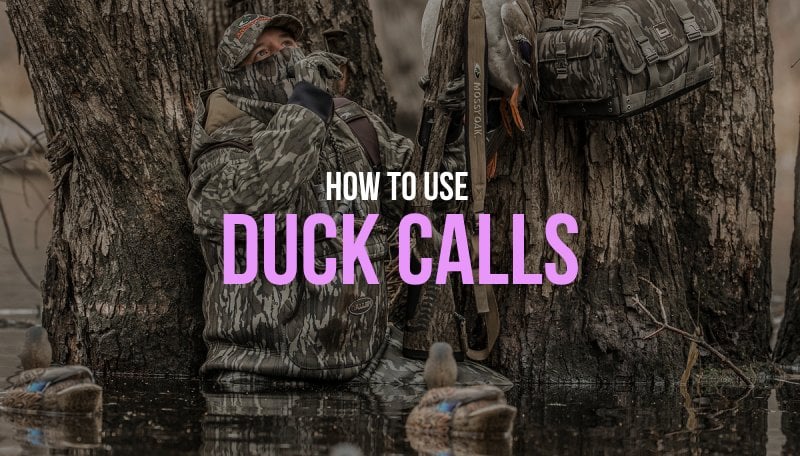
In this post, we’re discussing duck calling – what specific duck sounds mean and how you can imitate them using a duck call. Later on, we’ll highlight some of the best duck calls out there, explaining their functionality.
If you’re into bird hunting, we’ve got a cool guide to turkey calling that you might want to check out.
So, ready to talk some ‘duck’? Let’s get started!
Table of Contents
A Quick Guide to Duck Sounds
Ducks use a wide array of sounds to communicate. These calls range from the basic quack to the complex whistle. For now, let’s dive into different quack sounds, as these are easier to mimic for novices.
Mallard Duck Sounds
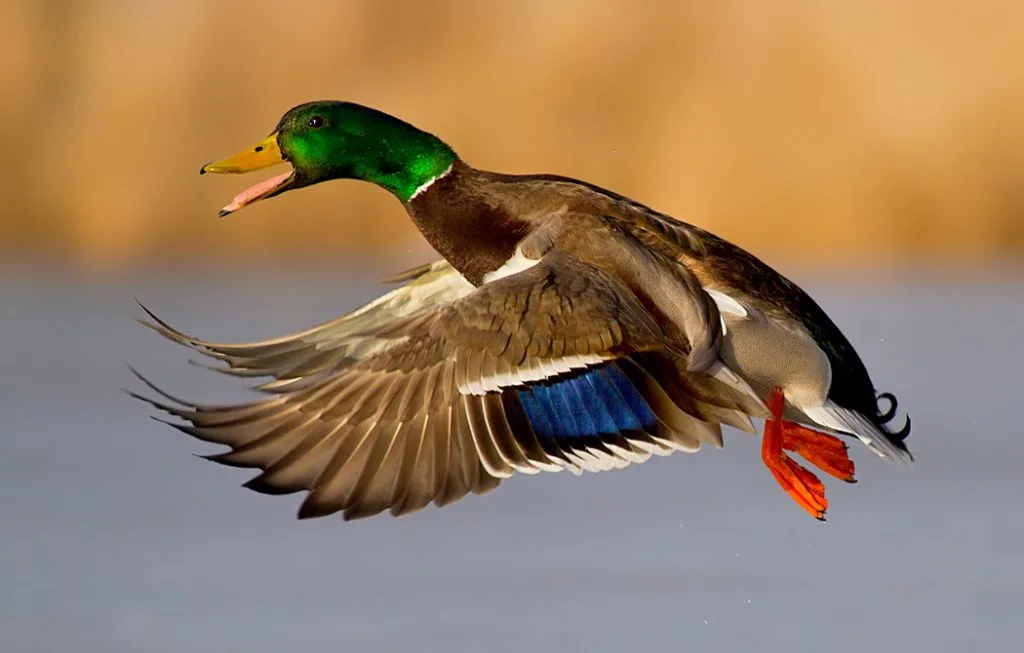
Basic Quack
Let’s start with the most familiar sound – a simple quack. It’s a versatile call, often used by female ducks to get attention or signal danger. It’s also commonly heard when ducks are either taking off or landing on water. When doing quacks, make slight shifts in the volume and pitch for each “quack” to sound as natural as possible. Make the definitive “ck” part crisp and clean.
Greeting Call
The duck greeting call is an excellent way to initiate ‘conversation’ with ducks, particularly when you first spot them at a distance. This call is characterized by a series of 5 to 7 rapid, excited quacks delivered in a descending order at a steady, even rhythm, something like “Kanc, Kanc, Kanc, Kanc, Kanc.”
Feeding Chuckle
Feed call is a soft, rhythmic sound (can be mimicked by saying “tikkitukkatikka”) that not only signals mealtime but also helps maintain group cohesion. However, many seasoned hunters advise using the feeding call sparingly, more as a tool to add variety to the calls. More common duck feed calls include “kitty, kitty, kitty” heard during the flight or more disjointed and erratic “da-dit da-dit dit dit, da-dit dit” heard when ducks are feeding.
Hail Call, Comeback Call, Pleading Call
The hail often draws divided opinions among professionals. Experts caution against its overuse. But if you do use it, remember not to hail call within 100 yards of the ducks and when the ducks are coming in. The call should be high, hard, and loud. Start with a long, strong “Aaaaaaink…Aaaaaink.., aaaaink, aaainkaink,” gradually tapering off.
Similar to the hail call, the comeback call is your go-to when ducks don’t respond to your greeting or when you want an immediate response, such as in timber. This call has a more urgent tone and faster rhythm, like “Kanckanc, Kanc, Kanc, Kanc”. Live hens usually only call to others after they have flown over the pond or passed their location, typically giving just one comeback call.
The pleading call, aka begging hail call, is used to capture the attention of stubborn ducks flying 75 to 200 yards above you. It’s as a series of 5 to 6 quacks that are elongated – “Kaaanc, Kanc, Kanc, Kanc,” with the first note usually held a bit longer. This call is essentially a drawn-out, slightly faster variation of the comeback call.
Lonesome Hen
This call isn’t often used by hunters, although it is a highly effective tool, particularly when dealing with call-shy ducks. This call is characterized by widely spaced, irregular, nasal, drawn-out “Quaaaaink” quacks typically made by a female duck seeking companionship.
The lonesome call should be quick, with several seconds of space between each quack. If the quacks are too close together, it may alarm the ducks. Also, remember that the lonesome hen call has a somewhat low and throaty tone.
Beyond Quacking: Sounds of Other Duck Species
While these are the common sounds you’ll hear when hunting mallards, it’s important to remember that wild duck species have their own unique set of calls. Not all communication among ducks involves quacking.
Pintail Sounds
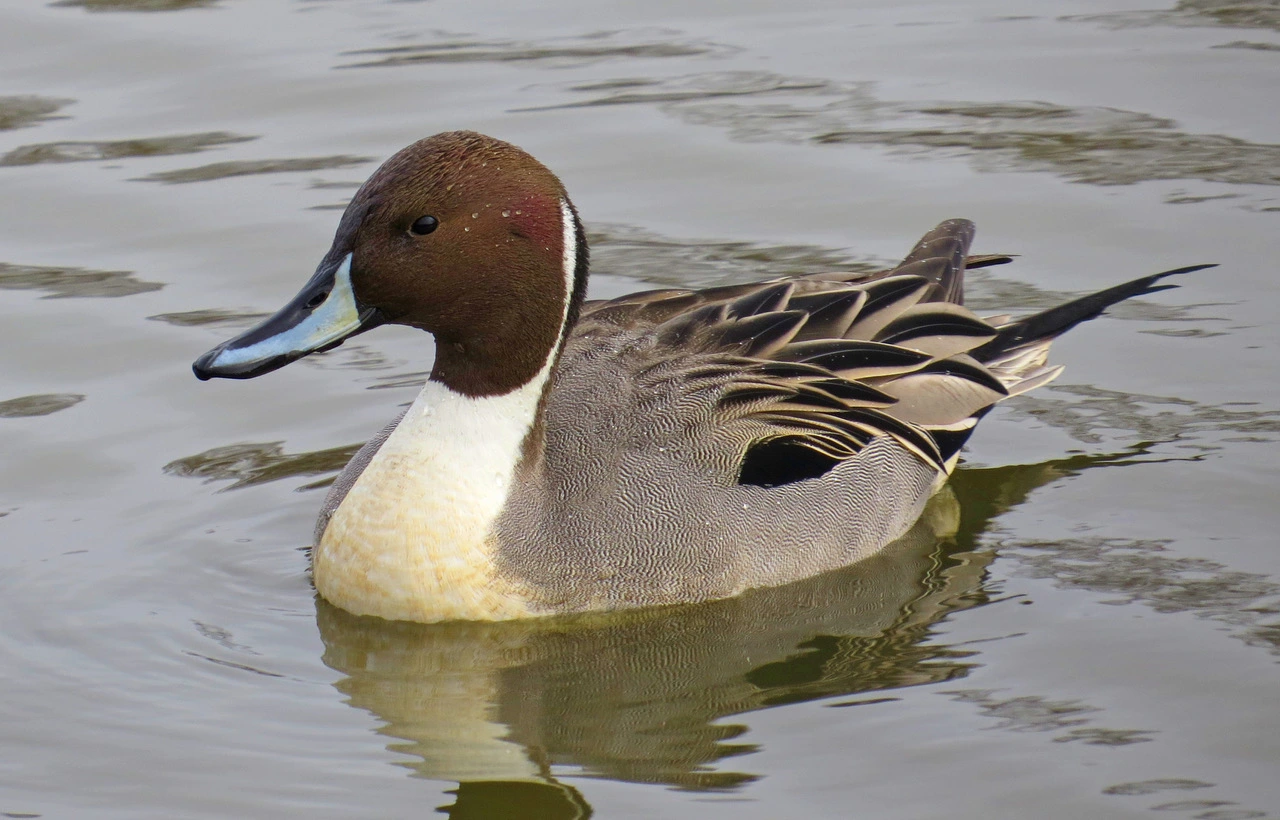
The pintail hen produces a sound similar to a mallard hen, only softer and more consistent in tone. Typically, she’ll make 3-4 low-pitched monotone quacks.
In contrast, the male pintail, or drake, makes a trilling whistle. To reproduce this call, you must roll your tongue, block the exhaust port at the end of the call with your finger, and do a one-second trill by rolling your tongue.
If you see a small group of pintails, say about six birds, make one short trill, then wait for four or five seconds, and repeat. This approach is especially beneficial later in the season when it becomes crucial to moderate your calling.
If you hunt with someone else, one person can make soft hen pintail quacks while another uses a whistle.
Generally, if you want to hunt specifically pintails, opt for larger marsh openings rather than smaller potholes – these ducks love vast ponds. And at least half of your decoy spread should be pintails.
Teal Sounds
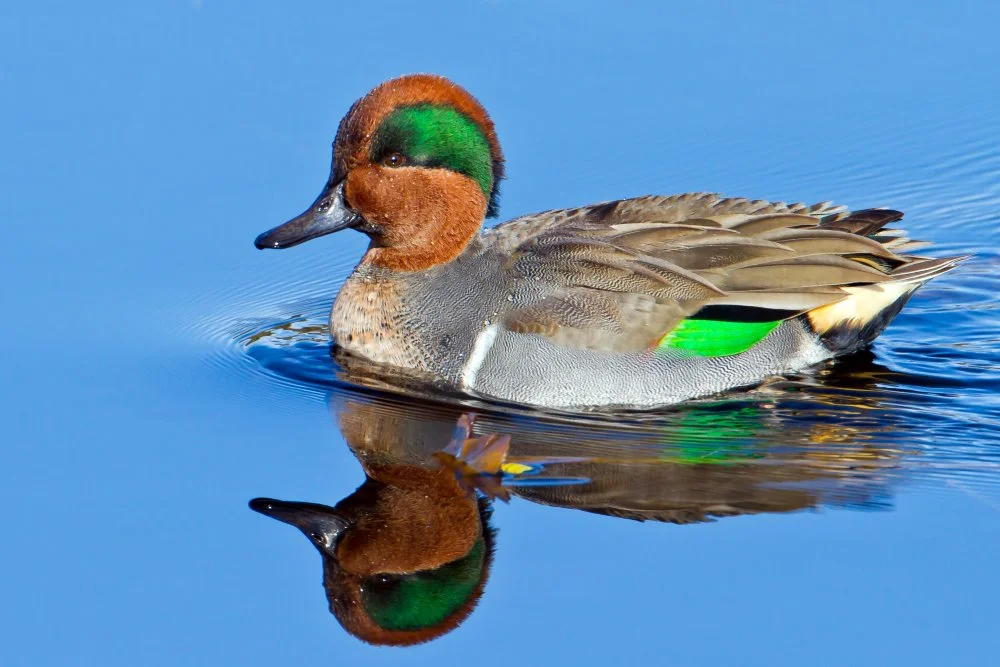
Blue-winged teal hunters often use a hen mallard greeting call but make it higher-pitched by applying more air and tongue pressure and faster-paced. There are also teal-specific calls available that are pre-tuned to a higher pitch.
Green-winged teals make a “peep-peep” call. This call is short but intense in volume. The rhythm can be described as “Peep! Peep-peep! Peep.”
Widgeon Sounds

Widgeon’s call is a simple two or three-note whistle, which is fairly easy to mimic. Phonetically, the widgeon’s call resembles “woo, whIT, woo,” each sound produced in a breathy manner. Given that widgeons are highly vocal and often travel in larger groups, it can be beneficial to have as many callers as possible using whistles.
Gadwall/Gray Duck Sounds
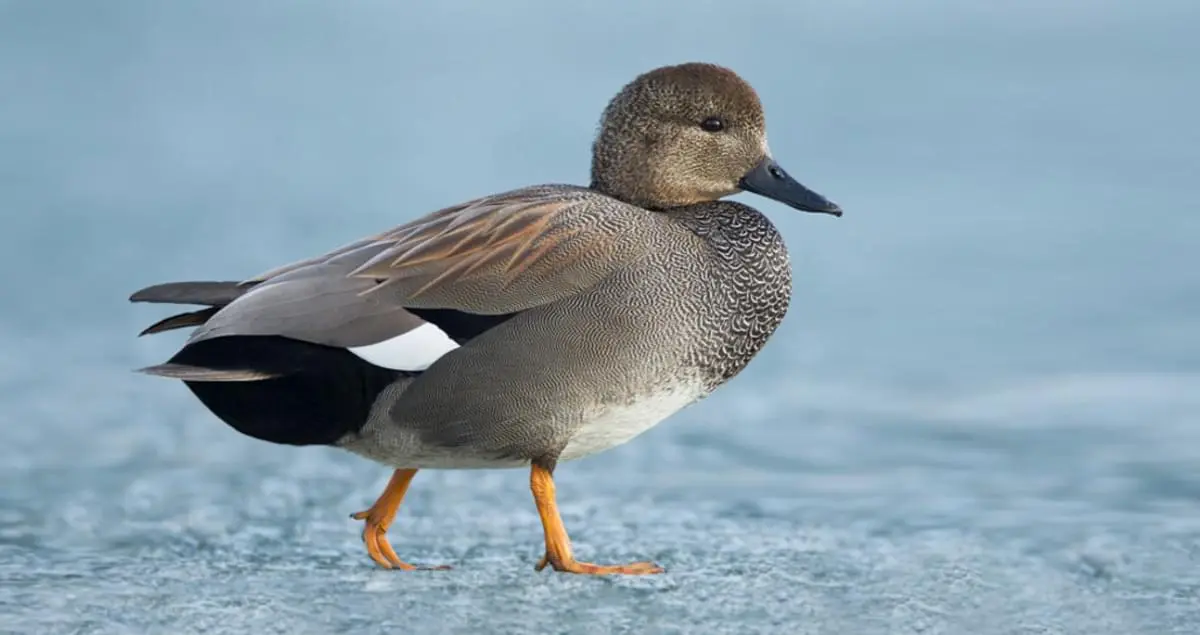
Gadwall ducks, particularly the drake, are known for their signature “dink… dink-dink” call. Some duck hunters suggest aggressive calling. The thing is that gray ducks are timid, and if something catches their eye, they take off immediately. Calling help to distract them.
While you can find dedicated gadwall calls on the market, you can also use a hen mallard call. Make 4-5 course notes with a fast rhythm.
Wood Duck Sounds

The absolute majority of wood ducks ignore calling. However, there are rare instances where a small flock returns to a forested wetland after hearing a wood duck call – a “peet – w-o-o-O-O-I-T” ascending whistle. Sometimes, the wood duck’s high-pitched “creeeeek – creeeeek” in-flight call can catch a flock’s attention. Probably the best wood duck calling strategy is to wait until the birds have landed and then lure them closer with the promise of a company using the whine.
Bluebill, Canvasback, and Redhead Duck Sounds
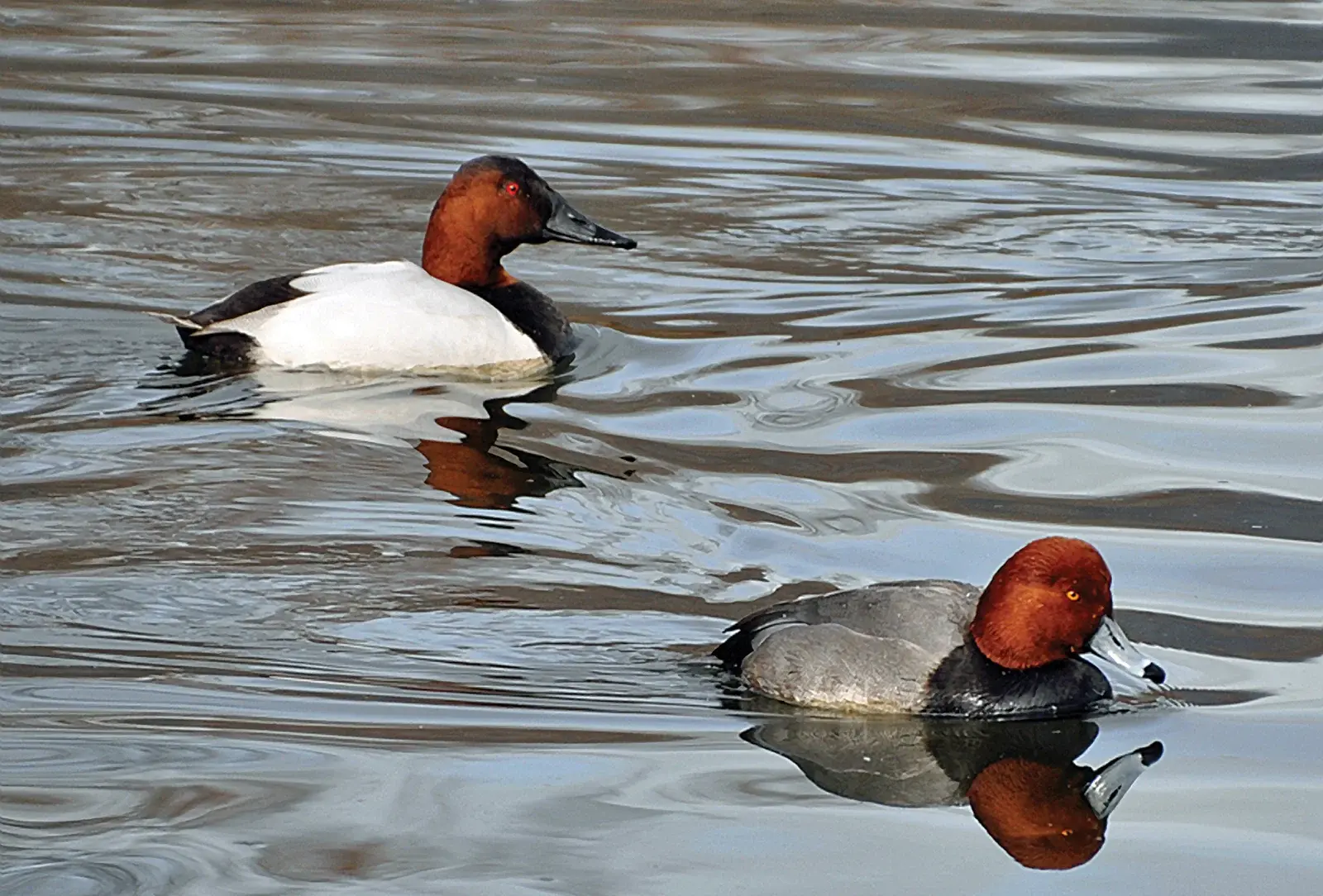
To reproduce the low-pitched, breathy guttural growl or rising “bbbuuurrrrrr” sound of the bluebill duck, a sound similar to those emitted by canvasbacks and redhead ducks, you need a make tongue flutter while growling into the call, which creates a sound that can be likened to sharp barks.
How to Choose a Duck Call
Types of Duck Calls
Single-Reed Duck Calls – A single-reed duck call is exactly what it sounds like – a duck call that operates with one reed. This type of call is known for its versatility due to its wide range of sounds. It can produce loud, high-pitched calls perfect for open water or mellow calls suitable for close encounters. The complexity of using a single-reed call lies in controlling the air pressure, which can be quite tricky for beginners.
Double-Reed Duck Calls – As the name suggests, these calls use two reeds. This gives them a unique, raspy tone that closely mimics the natural quack of a duck. Double-reed calls are typically easier to use compared to single-reed calls, making them an excellent choice for beginners. They lack the range and volume of single-reed calls, which can limit their effectiveness in open environments, but they are great tools for hunting puddle ducks.
Cut-Down Duck Calls – Cutdown duck calls feature a special cut-down design on the reed, which produces a sharp, aggressive sound. The cut-out call’s distinctive raspiness, variety of pitches, and high volume make it ideal for long-distance calling. However, mastering a cut-out call requires practice, as the unique design makes it a bit more challenging to handle.
Whistle Duck Calls – Lastly, we have whistle duck calls. Simple yet effective, these calls are designed to imitate the whistle-like sounds that drake mallards, pintail, wigeon, and green-winged teal produce. This type of call is generally easy to use and can be highly effective when used correctly. Whistle calls work best at close range and in situations where subtlety is key.
Duck Call Materials
The main thing you need to know is that the denser the material, the louder the call.
Wooden Duck Calls – More than just aesthetics, wooden duck calls offer a unique sound quality. They tend to produce a softer, mellow tone compared to their counterparts. This makes them ideal for close-range calling or in situations where you need to keep it subtle. However, they might lack the volume needed for long-distance calling.
Polycarbonate Duck Calls – Polycarbonate is a type of plastic that’s both durable and affordable. Polycarbonate calls can produce a decent volume, which makes them versatile for various hunting scenarios. They might not have the softness of wooden calls but make up for it with their robustness and reliability.
Acrylic Duck Calls – Acrylic is a dense material, which allows it to produce loud, sharp sounds that can reach far distances. This makes acrylic calls perfect for open-water hunting scenarios where volume is crucial. While they can be a bit pricier, their durability and sound quality make them a worthy investment for serious duck hunters.
Best Duck Calls – Review
PRIMOS High Roller Duck Call
- Type: Duck Whistle
- Material: Polycarbonate
This one is also designed for hunters who want a wide range of sounds in their arsenal. For pintail calling, hold the call between the thumb and middle finger, with the exhaust hole up and covering each side port. Blow sharp blasts of air through the call ending sharply. To sound like several pintails or vary pitch, cover and uncover side ports. To call teals, hold a lanyard ring and blow saying “peep, peep” at an irregular rapid pace without covering the ports. To mimic widgeon, blow three short blasts sounding like “We, WEE, Hoo” – on “We”, cover the side ports, uncover on “WEE”, and cover again on “Hoo”. For a mallard drake call, close the side ports and blow the sound “Zzz” into.
HAYDELS Big Barrelled Mallard Call
- Type: Cutdown Duck Call
- Material: Acrylic
This acrylic cutdown mallard call is designed for loud, aggressive calling, such as doing a comeback call. It’s perfect for open water scenarios where you need your call to reach far distances.
PRIMOS Easy Mallard Duck Call
- Type: Single Reed Duck Call
- Material: Plastic
Though single-reed, this Primos duck call incorporates a very thin reed and, thus, requires little air pressure, which makes it easy to blow – perfect for beginners. It’s capable of producing the full range of mallard hen calls.
DUCK COMMANDER Classic Commander
- Type: Double-Reed Duck Call
- Material: Wood
This Duck Commander call is designed to replicate the sound of a mallard hen, which makes it handy when also hunting blue-winged teals, gadwalls, and pintails. Thanks to an all-wood design, it produces warm, soft quacks, and a double-reed style makes it beginner-friendly.
PRIMOS Feedin’ Mallard Duck Call
- Type: Shaker-Style Duck Call
- Material: Plastic/Rubber
This call is unique in that it can mimic the feed chatter of a flock of mallards feeding in the water, adding a layer of background noise behind the main calling. This enhances the overall effect of calling and makes the spread sound more enticing to passing ducks. The special tuning hole in the bell of this call helps to alter the sound and rhythm to mimic realistic duck chatter.
Pay attention that the rubber portion of the call might require some extra care during extremely cold weather, as it can become rigid in low temperatures, affecting the quality of the sound. So keep the call inside your coat until ducks get closer to ensure it works optimally in cold conditions.
HAYDELS Diver Duck Call
- Type: Reed Duck Call
- Material: Plastic
The call is designed to mimic the distinctive sounds of diver ducks, including canvasbacks, redheads, and bluebills. It creates the “Brrr” sound and features a removable plug for volume control.
HAYDELS Duck Big Blue Wing Teal Call
- Type: Double-Reed Duck Call
- Material: Polycarbonate
This duck call is designed for calling blue-winged teal. It features double mylar reeds and produces very screechy duck quacks. The call is very loud and can work from a long distance, making it perfect for big-water hunts or cutting through nasty winds.
PRIMOS Original Wench Duck Call
- Type: Wench Duck Call
- Material: Polycarbonate
The PRIMOS Original Wench Duck Call features a patented tuning hole for varied pitch and sound. On the sounding board, you’ll see the “Tone Ridges” and “Tuning Ditches”. These special features prevent the reeds from sticking or freezing and allow the call to make raspy highs and lows, enabling hunters to fine-tune their calling strategy based on the situation and the behavior of the ducks they are trying to attract.
Also, read:
The Art of Using Game Calls: Part 1 – Deer Calls
The Art of Using Game Calls: Part 2 – Elk Calls
The Art of Using Game Calls: Part 3 – Turkey Calls
The Art of Using Game Calls: Part 5 – Coyote Calls
FAQs
What are some popular duck call brands?
Some well-known duck call brands include Duck Commander, RNT Calls, Echo Calls, Rolling Thunder, Buck Gardner, Primos, and Haydels.
How do I choose the right duck call?
When choosing a duck call, consider factors such as the type of ducks you’re hunting, your skill level, the call material, and the sound the call produces. It’s always a good idea to try out different calls to see which one works best for you.
Can I use the same duck call for all types of ducks?
While some duck calls can be used for multiple species, others are designed to mimic the specific calls of certain types of ducks. Always check the product description to ensure the call you choose is suitable for the ducks you plan to hunt.




Leave a Reply